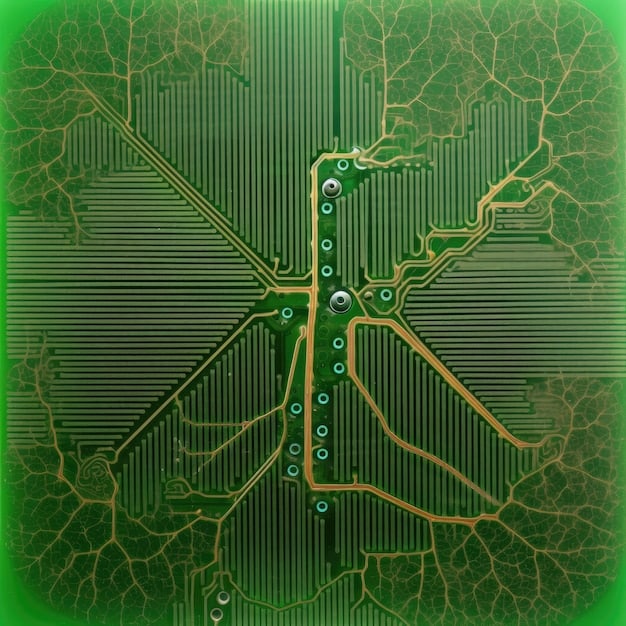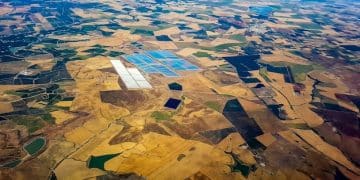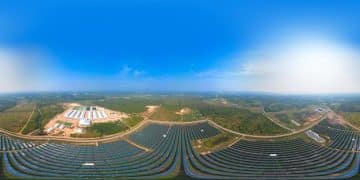Renewable Energy and the Grid: Shaping a Sustainable Future

Renewable energy integration into the grid is transforming the energy sector, addressing climate change and energy security through innovative technologies and policy advancements for a sustainable future.
The integration of renewable energy and the grid: how integration is shaping the future is no longer a distant prospect but a rapidly evolving reality. As we become more aware of the urgent need to transition from fossil fuels to more sustainable energy sources, understanding how these renewables can be seamlessly integrated into our existing power grids is crucial creating a greener and more resilient energy landscape for future.
Understanding the Basics of Renewable Energy Integration
The integration of renewable energy sources into the electrical grid is a complicated process that is necessary to create a long-term energy system. It entails a number of steps, including generation, transmission, distribution, and regulation.
What is the Electrical Grid?
The electrical grid, often known as the power grid, is a complex network that is used to transport electricity from producers to consumers. A network of generating plants, high-voltage transmission lines, substations, and distribution lines form this intricate system, which functions as the foundation of contemporary electrical infrastructure.
Challenges of Integrating Renewables
Integrating renewable energy sources into the grid presents a number of distinct challenges. Renewable energy sources, in contrast to traditional fossil fuel-based power plants, are erratic due to weather conditions such as sunlight, wind, and water currents. Maintaining grid stability in the face of unpredictable renewable energy output calls for sophisticated control systems and forecasting techniques.
- Ensuring Grid Stability: Overcoming the intermittency of renewable sources.
- Upgrading Infrastructure: Addressing the need for grid modernization to handle bidirectional energy flow.
- Policy and Regulatory Frameworks: Establishing frameworks that support renewable energy integration.

The Role of Technology in Grid Modernization
Numerous technological developments are essential to the modernization of the grid, which makes it possible to smoothly integrate renewable energy resources and improve the overall effectiveness and dependability of electrical networks.
Smart Grids and Advanced Metering Infrastructure (AMI)
Smart grids are electrical networks that use digital technology to improve the efficiency, dependability, and transparency of power supply. Modern Metering Infrastructure (AMI) consists of intelligent meters that permit two-way communication between utility companies and consumers, which enables real-time monitoring and control of energy use.
Energy Storage Solutions
Energy storage technologies, such as batteries, pumped hydro storage, and thermal storage, play an important role in mitigating the intermittency of renewable energy sources. Energy storage enables utilities to store excess renewable energy during periods of high production and release it when demand is high or when renewable energy generation is low.
- Battery Storage Systems: Enhancing grid stability and reliability.
- Pumped Hydro Storage: Utilizing water reservoirs to store and generate electricity.
- Thermal Storage: Storing heat or cold for later use in heating and cooling applications.
Policy and Regulatory Frameworks Supporting Integration
Government rules and supportive regulations are essential to encouraging the integration of renewable electricity sources into the grid. These guidelines offer producers, utilities, and consumers of renewable energy the framework, incentives, and standards they need to participate in and promote a transition to a more sustainable energy landscape.
Renewable Portfolio Standards (RPS)
Renewable Portfolio Standards (RPS) are regulations that mandate that a certain proportion of electricity be generated from renewable energy sources. By establishing clear targets for renewable energy generation, RPS policies encourage utilities to invest in renewable energy projects and diversify their energy mix.
Incentives and Subsidies
Incentives and subsidies, such as tax credits, grants, and rebates, play an important role in lowering the financial obstacles to the use of renewable energy technologies. These financial incentives encourage individuals, organizations, and communities to adopt renewable energy solutions by lowering the upfront costs of setting up renewable energy systems.

Economic Benefits of Renewable Energy Integration
Integrating renewable energy into the grid provides a number of financial advantages in addition to environmental benefits, including lower energy costs, job creation, and economic growth.
Job Creation and Economic Growth
The renewable energy sector has the potential to generate a substantial number of jobs in a variety of industries, including manufacturing, installation, maintenance, and project development. Investing in renewable energy projects stimulates economic growth by increasing domestic energy production, lowering reliance on imported fuels, and supporting local businesses.
Reduced Energy Costs
Renewable energy sources, such as solar and wind, have minimal operational expenses because they do not need fuel. Integrating renewable energy into the grid can moderate energy costs for consumers and companies by lowering the reliance on fossil fuels, which are subject to price fluctuations and geopolitical concerns.
Case Studies: Successful Integration Projects
Examining real-world case studies of successful renewable energy integration projects that are essential to understanding the practical applications, difficulties, and advantages of integrating renewable energy sources into the power grid. These case studies offer insightful information on the effectiveness of different techniques and the variables that promote successful project implementation.
California’s Renewable Energy Initiatives
California is a leader in renewable energy adoption, with ambitious goals and initiatives to transition to a carbon-free electricity sector. California’s Renewable Portfolio Standard (RPS) mandates that utilities obtain a certain proportion of their electricity from renewable sources, such as solar, wind, and geothermal.
Denmark’s Wind Power Integration
Denmark has made considerable progress in incorporating wind power into its electricity grid. Wind energy regularly accounts for more than 40% of Denmark’s electricity generation, demonstrating the viability and dependability of wind power as a substantial energy source.
- Advanced Grid Management: Employing sophisticated technologies to balance supply and demand.
- Cross-Border Collaboration: Partnering with neighboring countries to manage energy surpluses and deficits.
- Investment in Infrastructure: Upgrading transmission lines and grid infrastructure to support wind energy integration.
Future Trends and Innovations in Grid Integration
The field of grid integration is always developing, and new trends and technology have the potential to completely change the way renewable energy sources are incorporated into electrical grids. It is possible to foresee and accept the developments that will influence the future of sustainable energy systems by being informed about these developments.
Advancements in Smart Grid Technologies
Sophisticated sensors, sophisticated analytics tools, and automated control systems are used in smart grid technologies to improve grid dependability, efficiency, and resilience. These developments make it possible to monitor the grid in real time, spot faults, improve energy flow, and improve overall grid performance.
The Rise of Microgrids and Distributed Generation
Microgrids are localized power networks that can run independently or in conjunction with the major electrical grid. Microgrids are becoming increasingly common as a way to improve energy resilience, dependability, and sustainability. Distributed generation (DG) entails generating electricity near consumption locations, such as houses, businesses, and industrial facilities.
| Key Point | Brief Description |
|---|---|
| 💡 Grid Modernization | Essential for integrating renewables efficiently; includes smart grids and advanced metering. |
| 🔋 Energy Storage | Critical for managing the intermittency of renewable sources like solar and wind. |
| 📜 Policy Support | Government policies like RPS and incentives drive renewable energy adoption and grid integration. |
| 🌍 Economic Benefits | Renewable integration fosters job creation, economic growth, and reduced energy costs. |
Frequently Asked Questions (FAQ)
▼
Renewable energy integration involves incorporating renewable energy sources like solar, wind, and hydro into the existing electrical grid. This process ensures these sources can contribute effectively to the overall energy supply.
▼
Grid modernization is crucial because it upgrades the infrastructure to handle the variable nature of renewable energy. Smart grids facilitate better monitoring, control, and management of renewable energy flows.
▼
Energy storage systems, such as batteries and pumped hydro, store surplus renewable energy during high production periods. This stored energy can then be released when demand is high or renewable generation is low, ensuring a stable supply.
▼
RPS are policies that require utilities to generate a specific percentage of their electricity from renewable sources. These standards drive investment in renewable energy and help diversify the energy mix, promoting sustainable energy growth.
▼
Integrating renewable energy leads to job creation in manufacturing, installation, and maintenance. It also reduces reliance on fossil fuels, stabilizing energy costs and stimulating economic growth by promoting local energy production.
Conclusion
The integration of renewable energy and the grid signifies a transformative shift towards a sustainable and resilient energy future. Overcoming the challenges through technological advancements, supportive policies, and strategic investments will pave the way for a cleaner, more secure, and economically vibrant energy landscape. Embracing these changes is essential for a sustainable planet.





